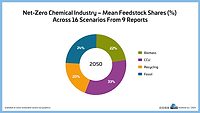Dow to Build Net-Zero Carbon Emissions Ethylene and Derivatives Complex
Subject to approval by Dow’s board of directors and various regulatory agencies, the investment would decarbonize approximately 20% of Dow’s global ethylene capacity while growing polyethylene supply by about 15%.

Dow recently announced its plan to build what it calls the world’s first net-zero carbon emissions integrated ethylene cracker and derivatives site, with respect to scope 1 and 2 carbon dioxide emissions. The project would more than triple Dow’s ethylene and polyethylene capacity from its Fort Saskatchewan, Alberta, Canada, site while retrofitting the site’s existing assets to net-zero carbon emissions. The organic, brownfield investment would significantly increase Dow’s capacity of advantaged ethylene, polyethylene, and derivatives manufactured across Alberta. The company expects to allocate approximately $1 billion of capex annually to decarbonize its global asset base in a phased, site-by-site approach.
Dow expects the new brownfield ethylene cracker to add approximately 1.8 million metric tons of capacity in a phased manner through 2030. Along with derivatives capacity and site retrofit investments, this will reportedly enable the company to produce and supply approximately 3.2 million metric tons of certified low- to zero-carbon emissions polyethylene and ethylene derivatives for customers and joint venture partners around the globe.
The investment, which is subject to approval by Dow’s board of directors and various regulatory agencies, would decarbonize approximately 20% of Dow’s global ethylene capacity while growing polyethylene supply by about 15%. Further, Dow estimates that the project can be completed with an approximately 15% lower capital intensity than the company’s Texas-9 cracker and derivative units.
“This investment builds on Dow’s strong leadership position and allows us to meet the increasing needs of customers and brand owners seeking to lower the carbon footprint of their products,” said Jim Fitterling, chairman and CEO. “Our advantaged position and disciplined approach to capital investment makes us well positioned to lead the industry in decarbonizing, growing and accelerating Dow’s path toward carbon neutrality.”
The production process at Fort Saskatchewan will convert cracker off-gas into hydrogen as a clean fuel to be used in the production process, and carbon dioxide that would be captured onsite to be transported and stored by adjacent third-party CO2 infrastructure. The products produced at the site will be used globally to help deliver low- to zero-carbon emissions solutions to meet customers’ sustainability needs.
Learn more about Dow at www.dow.com.
Looking for a reprint of this article?
From high-res PDFs to custom plaques, order your copy today!





